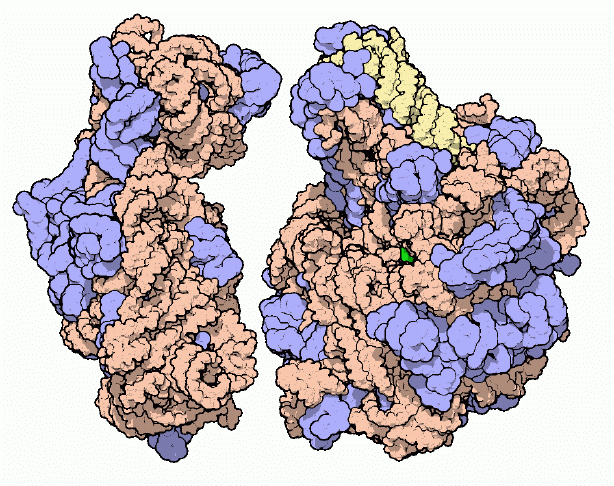|
Inhaltsübersicht | Nanomaschinen | Moleküle | Programme | Kurse | Fun | Links |
||
| > |
Ribosome
The Protein Factory
Protein synthesis is the major task performed by living cells. For instance, roughly one third of the molecules in a typical bacterial cell are dedicated to this central task. Protein synthesis is a complex process involving many molecular machines. You can look at many of these molecules in the PDB, including DNA, DNA polymerases, and RNA polymerases; a host of repressors, DNA repair enzymes, topoisomerases, and histones; tRNA and acyl-tRNA synthetases; and molecular chaperones. This month, for the first time, you can also look at the factory of protein synthesis in atomic detail.
An Elusive Structure
The ribosome has been under the scrutiny of scientists for decades. Electron microscopy has yielded an increasingly detailed view over the years, defining the overall shape of individual ribosomes and differences in this shape for ribosomes from different species. More recently, detailed electron micrograph reconstructions have studied the interaction of ribosomes with messenger RNA, transfer RNA and the protein elongation factors. This legacy of morphological work lays the groundwork on which the atomic structures may be understood.
Ribosomes are composed of two subunits: a large subunit, shown on the right, and a small subunit, shown on the left. Of course, the term "small" is used in a relative sense here: both the large and the small subunits are huge compared to a typical protein. Both subunits are composed of long strands of RNA, shown here in orange and yellow, dotted with protein chains, shown in blue. When synthesizing a new protein, the two subunits lock together with a messenger RNA trapped in the space between. The ribosome then walks down the messenger RNA three nucleotides at a time, building a new protein piece-by-piece.

Next: The Large Subunit
Last changed by: A.Honegger,